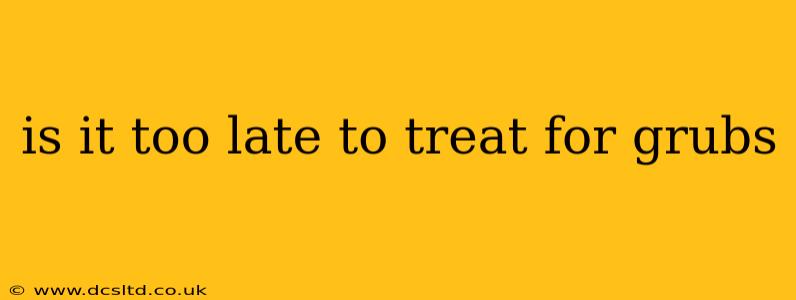Finding grubs in your lawn can be disheartening, especially if you're unsure whether treatment is still effective. The answer to whether it's too late to treat for grubs depends on several factors, including the type of grub, your geographic location, and the current stage of their life cycle. This guide will help you determine the best course of action.
What are Grubs?
Grubs are the larval stage of certain beetles, most commonly June beetles, Japanese beetles, and masked chafers. These larvae feed on the roots of your grass, causing significant damage that manifests as brown patches, weakened turf, and susceptibility to disease. Knowing the type of grub infesting your lawn is crucial for effective treatment, as different species have varying life cycles and sensitivities to insecticides.
When is the Best Time to Treat for Grubs?
The optimal time to treat for grubs is preventative, typically during their active feeding period in late summer and early fall (August-October in many regions). This allows the insecticide to reach the grubs before they cause significant damage. However, even if you discover an infestation later, treatment may still be beneficial.
Is It Too Late if I See Grubs in the Fall?
Even if you discover grubs in the fall, treatment is often still worthwhile. While they may be nearing the pupal stage (where they transform into adult beetles), many products remain effective, targeting the existing grubs before they pupate and overwinter. This can significantly reduce the population for the following year. The effectiveness will depend on the specific insecticide and the severity of the infestation.
What About Treating for Grubs in Spring or Early Summer?
Treatment in spring or early summer is less effective as the grubs are often nearing adulthood and will soon emerge from the soil as beetles. Focus instead on preventing future infestations by treating in the late summer/early fall. Any damage already done will need to be addressed with lawn repair techniques.
What are the Signs of a Grub Infestation?
Recognizing the signs of a grub infestation early is key to successful treatment. Look for these indicators:
- Brown patches: These are often irregularly shaped and may be accompanied by dying or thinning grass.
- Weak turf: The grass will easily pull up from the soil, revealing the grubs feeding on the roots.
- Birds and skunks: These animals are attracted to grubs and may dig in your lawn to feed on them.
- Grubs themselves: Carefully examine the soil by pulling up small sections of turf.
What are the Different Grub Treatment Options?
Several options exist for treating grubs, ranging from chemical insecticides to biological controls. Consult with a local lawn care professional or your garden center for the best recommendations for your specific region and type of grub. They can help determine the appropriate treatment strategy based on the severity of the infestation and your personal preferences.
How Effective are Grub Treatments in Different Seasons?
The effectiveness of grub treatments varies depending on the season. Fall treatments are generally the most effective as they target grubs during their active feeding stage. Spring and summer treatments are less effective because the grubs are nearing the end of their larval stage and preparing to pupate.
Can I Prevent Grubs From Infesting My Lawn?
Yes, several preventative measures can help reduce the risk of a grub infestation:
- Maintain a healthy lawn: A thick, healthy lawn is less susceptible to grubs.
- Proper watering: Avoid overwatering, as this can create favorable conditions for grubs.
- Use a soil test: This helps identify any nutrient deficiencies that make your lawn more susceptible.
In conclusion, while the best time to treat for grubs is in late summer and early fall, it's not necessarily too late if you discover them later in the year. However, prompt action and accurate identification are crucial for effective treatment and minimizing lawn damage. Consulting a professional is always a good idea for diagnosis and treatment recommendations.
